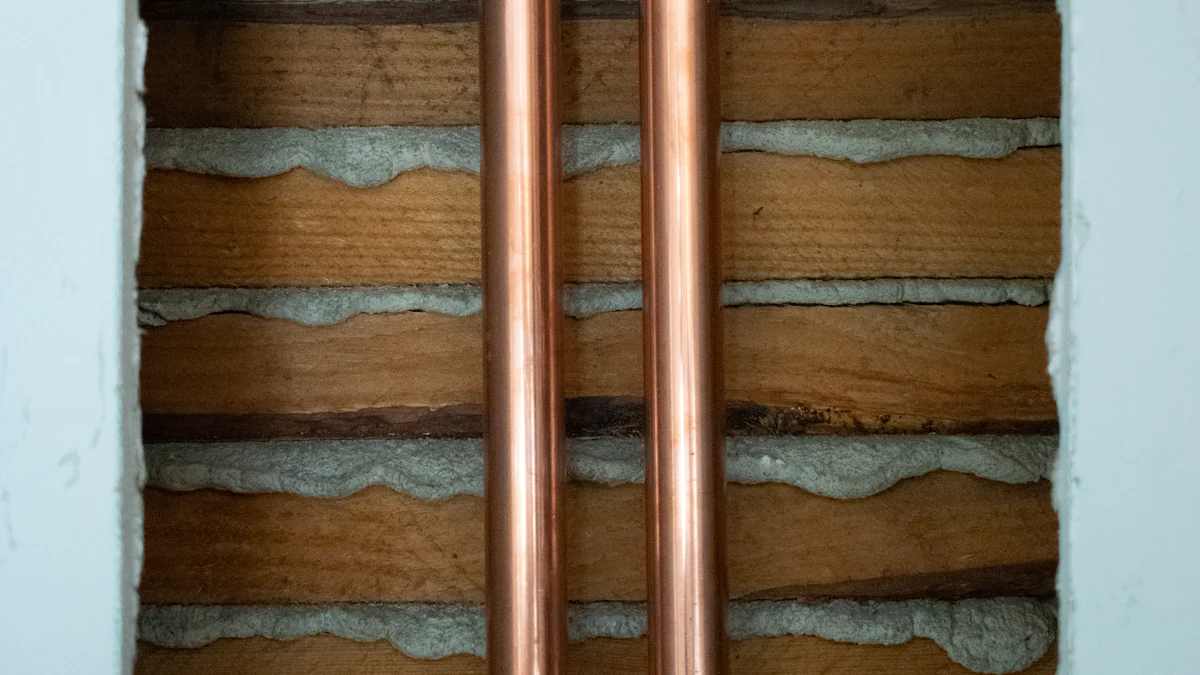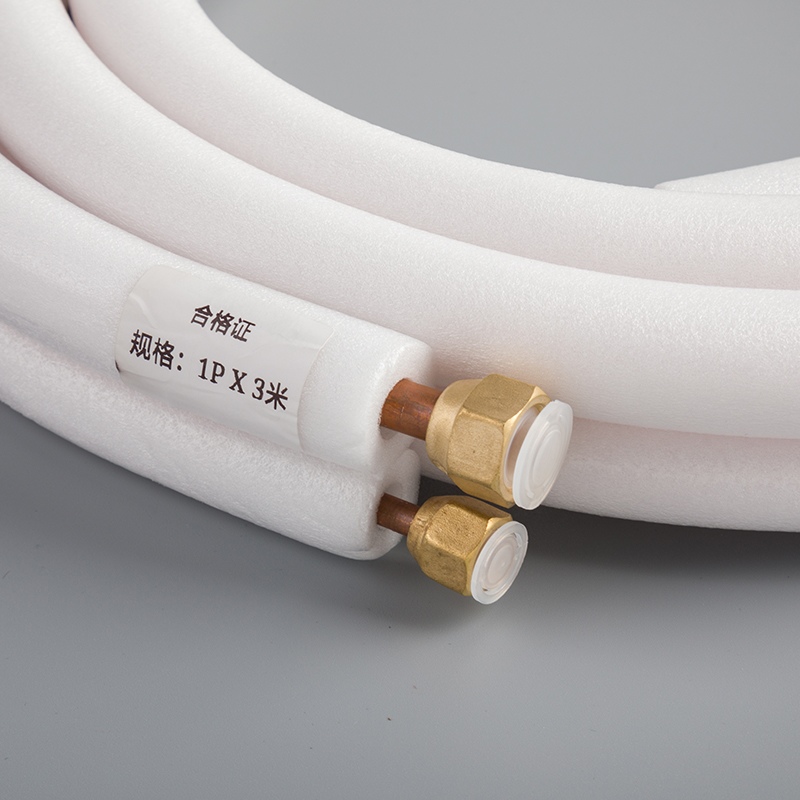Discover the Ideal Insulation for Copper Pipes

What type of insulation is used for copper pipes? Insulating copper pipes is crucial for preventing heat loss and reducing utility bills. Homeowners who insulate their pipes can save an average of $3.74 per linear foot annually. This blog will delve into the significance of insulating copper pipes, providing insights on various insulation materials commonly used. By understanding the benefits and options available, readers can make informed decisions to enhance energy efficiency in their homes.
What type of insulation is used for copper pipes?

Foam Insulation, such as polyurethane foam or phenolic foam, is a popular choice for insulating copper pipes due to its excellent thermal insulation and moisture resistance properties. These closed-cell insulation materials are denser, providing a high R-value that makes them ideal for extreme temperature conditions.
Compatibility with copper pipes
Foam insulation is highly compatible with copper pipes, ensuring a snug fit that effectively prevents heat loss and maintains energy efficiency. Its versatile nature allows it to conform seamlessly to the shape of the pipes, creating a tight barrier against external elements.
Easy installation with adhesive
One of the key advantages of foam insulation is its ease of installation using adhesive. This adhesive not only secures the insulation in place but also acts as a sealant, further enhancing the protective barrier around the copper pipes. The straightforward installation process makes it a practical choice for both residential and industrial applications.
Fiberglass and Mineral Wool
Fiberglass and mineral wool are also commonly used for insulating copper pipes, offering diverse applications across various industries. These materials provide effective thermal protection while offering flexibility in insulation thickness variations based on specific needs.
Common applications
Fiberglass and mineral wool find widespread use in heating, ventilation, air conditioning, petrochemical, and maritime sectors due to their reliable thermal performance. Their adaptability makes them suitable for different pipe diameters and environmental conditions.
Insulation thickness variations
The versatility of fiberglass and mineral wool allows for varying levels of insulation thickness to accommodate different requirements. From standard residential installations to industrial settings, these materials can be tailored to ensure optimal energy efficiency and cost-effectiveness.
Polyurethane Foam
Polyurethane foam stands out for its role in construction projects by providing exceptional thermal performance, moisture resistance, and longevity as an insulating material.
Industrial applications
In industrial settings where robust insulation is crucial, polyurethane foam excels in maintaining temperature control and preventing energy loss. Its durability makes it a preferred choice for demanding environments.
Thickness requirements
With specific thickness requirements ranging from standard applications to extreme conditions, polyurethane foam offers customizable solutions tailored to each project's unique demands.
Benefits of Insulating Copper Pipes

Energy Efficiency
Wrapping copper pipes with foam insulation is a key step in enhancing energy efficiency. By creating a barrier that prevents heat loss, the insulation ensures that hot water maintains its temperature as it travels through the pipes. This simple yet effective solution significantly reduces wasted energy and ultimately leads to lower utility bills.
Reduced heat loss
Insulating copper pipes with foam helps in reducing heat loss during the transportation of hot water. The insulation acts as a protective layer, keeping the heat within the pipes and preventing unnecessary dissipation. This results in a more efficient heating system and less energy consumption overall.
Lower energy bills
The use of foam insulation on copper pipes directly translates to cost savings for homeowners. By minimizing heat loss, the insulation reduces the workload on water heaters, leading to lower energy consumption and subsequently decreased utility bills. It's a practical investment that pays off in both comfort and financial benefits.
Preventing Condensation
In addition to improving energy efficiency, insulating copper pipes also plays a crucial role in preventing condensation issues. When cold water flows through uninsulated pipes, condensation can form on the exterior, potentially causing water damage and compromising pipe integrity.
Avoiding water damage
Foam insulation serves as a protective shield against condensation buildup on copper pipes. By maintaining consistent temperatures within the pipes, the insulation prevents moisture from accumulating on the surface. This proactive measure safeguards against potential water damage and extends the lifespan of the plumbing system.
Maintaining pipe integrity
Insulation not only protects against external factors like condensation but also contributes to preserving the structural integrity of copper pipes. By regulating temperature fluctuations, the insulation minimizes stress on the pipes, reducing the risk of corrosion or leaks over time.
Noise Reduction
Beyond its thermal benefits, insulating copper pipes can also contribute to creating a quieter environment by minimizing sound transmission along plumbing systems.
Minimizing sound transmission
The use of foam insulation dampens vibrations and reduces noise generated by water flow within copper pipes. This acoustic barrier effectively absorbs sound waves, diminishing disruptive noises throughout residential or industrial spaces.
Creating a quieter environment
By implementing proper insulation measures, homeowners can enjoy a peaceful living environment free from intrusive plumbing noises. The reduction in sound transmission enhances overall comfort levels and promotes a tranquil atmosphere within homes or commercial buildings.
Choosing the Right Insulation
Application-Specific Needs
Residential vs. industrial uses
Closed-cell insulation materials provide excellent thermal insulation and moisture resistance, making them suitable for residential applications. They effectively maintain energy efficiency in homes by minimizing heat loss and reducing utility bills.
Aerogel insulation, known for its exceptional thermal properties, is more commonly utilized in industrial settings due to its high performance but tends to be pricier. It ensures optimal temperature control in demanding environments where precision is crucial.
Climate considerations
When considering climate variations, closed-cell insulation materials offer reliable protection against extreme temperatures, making them versatile for different weather conditions. They adapt well to both hot and cold climates, providing consistent thermal efficiency year-round.
Aerogel insulation excels in climates with significant temperature fluctuations, offering superior thermal performance that remains stable even in challenging environmental conditions. Its advanced insulating capabilities make it a preferred choice for industries requiring precise temperature management.
Material Properties
Durability and lifespan
Closed-cell insulation materials are durable and long-lasting, with a lifespan that extends the effectiveness of the insulation investment. Their robust construction ensures continued thermal protection over an extended period, reducing maintenance needs and costs.
Mineral wool and fiberglass insulation are renowned for their durability, offering reliable thermal performance throughout their lifespan. These materials withstand environmental factors and mechanical stress, maintaining their insulating properties over time without compromising efficiency.
Cost-effectiveness
In terms of cost-effectiveness, closed-cell insulation materials provide a practical solution for homeowners seeking efficient thermal protection at a reasonable price point. Their long-term benefits outweigh the initial investment, resulting in significant savings on energy expenses.
Mineral wool and fiberglass insulation offer cost-effective options for various applications by balancing affordability with performance. These materials deliver consistent thermal efficiency at competitive prices, making them accessible choices for residential and industrial projects alike.
Installation and Maintenance
Ease of installation
Closed-cell insulation materials are easy to install due to their flexible nature that allows seamless application around copper pipes. Homeowners can efficiently insulate their plumbing systems without extensive labor or specialized tools, saving time and effort during the installation process.
Mineral wool and fiberglass insulation also boast straightforward installation procedures that cater to different project requirements. Their versatility enables quick and hassle-free application on copper pipes, ensuring efficient coverage for enhanced energy conservation.
Maintenance requirements
When it comes to maintenance, closed-cell insulation materials require minimal upkeep once installed properly. Their resilient composition resists wear and tear over time, reducing the need for frequent inspections or replacements.
Mineral wool and fiberglass insulation exhibit low maintenance requirements by retaining their insulating properties without regular interventions. Homeowners benefit from long-term energy savings without significant maintenance costs associated with these durable materials.
To summarize, insulating copper pipes with the right materials like foam, fiberglass, or mineral wool is crucial for maintaining energy efficiency and preventing heat loss.
Choosing the appropriate insulation ensures optimal performance and long-term cost savings for both homeowners and industry professionals.
For a successful insulation project, it is recommended to consider the specific application needs, material properties, and ease of installation to achieve maximum benefits.
See Also
Essential Insulation Options for Copper Pipe Knowledge
Insider Tips: Enhance AC Efficiency Using Copper Piping
Exploring Optimal Copper Pipe Connectors for Plumbing


